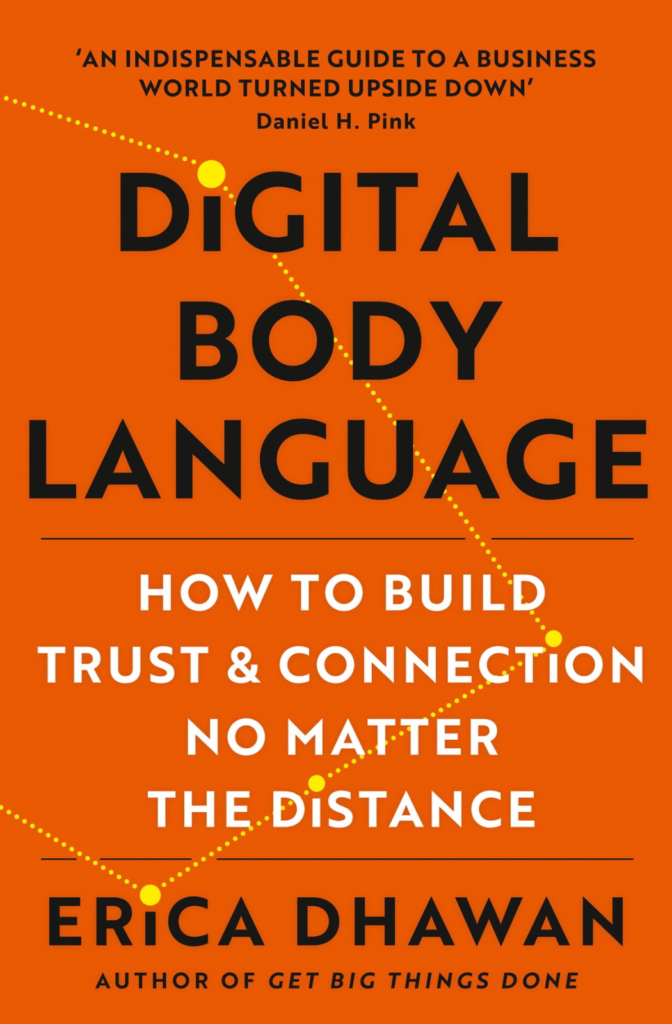Digital Body Language was written by Erica Dhawan and published on May 11th 2021 and discusses how you can create trust and connection regardless of the distance. Humans depend on body language to associate and build trust. Yet, essentially, most of our communication goes on behind the screen. Traditional body language gestures are no longer perceptible, are they? In Digital Body Language, Erica Dhawan, the author, combines ground-breaking research with engaging storytelling to decipher the new signals and cues that have replaced traditional body language gestures.
HOW THIS BOOK HELPED US?
Digital Body Language helped us understand our common challenges when implementing digital communication. Over 70% experience some unclear communication with their workmates. Sometimes you might need to be more accurate with your colleague and send the wrong reply. Also, the book helped us understand the difference between brief and precise messages. Brief messages have low context and are cryptic. Recipients of unclear messages think a lot about filling in the missing words in the message.
THE BOOK EXPLAINED UNDER 60 SECONDS
Digital Body Language explains how you can create trust and connection when communicating digitally. It highlights the four laws of digital body language: value visibly, communicating carefully, collaborating confidently and trust totally. The book also discusses how different generations use digital body language but interpret the same digital body language cues differently.
TOP THREE QUOTES
- “The loss of nonverbal body cues is among the most overlooked reasons why employees feel so disengaged from others.”
- “If people are doing things out of fear, it’s hard or impossible to drive any innovation. Trust Totally shows up through our actions and communications in times both good and bad.”
- “The higher a woman’s status and power, the more she’s learned to adopt more traditional male body language and ways of communicating.”
BOOK SUMMARIES AND NOTES
Part One: Digital Elements of Style

What Is Digital Body Language
No one needs a linguistics degree to comprehend that our communication approaches, especially today, are more confusing than ever. Contemporary communication relies more than ever on how you say something rather than what you say. And that’s your digital body language. When the internet took shape, everyone was given a platform and a mic, but no one was taught how to use them. Everyone just picked up things and went along. Mistakes made along the way have had a real impact on business. In the end, texts, emails, instant messages and video calls are visual communication. Everyone has contrasting assumptions and instincts about whether it’s proper to send a text, or an email, when to look into the camera during a video call, and how to write a digital apology without looking sloppy or fake. The words you choose, the time you take to respond, your video call styles and email sign-offs generate perceptions that can improve or ruin your work and personal relationships.
Emotional intelligence is your ability to read other people’s signals and respond to them suitably while comprehending and appreciating other people’s perspectives. Creating connections and reading other people’s signals when most of our digital communication becomes difficult, and our ability to care is compromised.
Digital body language offers a systematic strategy to comprehend the signs of the digital world so that we can interpret those of the physical world. It spots and explains the evolving standards and cues of digital communications within companies.
Why Are You So Stressed
How can you avoid paranoia and confusion with anyone? When dealing with obscurity from someone else, here are two questions that’ll help you decide what to do next: Who has more or less power in the relationship? How much do we trust each other?
For instance, think about how fast you might respond to a request from your boss, who has more power than you. In such a case, your fast response concedes that power. Now think about how fast you might respond to your junior, who has less power. You’ll probably prioritise speed, clarity and essential messages with your boss and clients but send one-line messages without a subject line to a junior. It’s so because your boss’ higher power encourages you typically to be more careful with your digital body language.
What and how we signal usually depends on how much we trust the person we communicate with. When you email a close colleague you’ve worked with for years, and your trust is high, he’s likely to interpret a short message as a signal that you’re busy. But when your trust is low because of a turf war at work, he may interpret your brevity as a sign of resentment or anger. The Trust and Power Matrix is the best way to control hidden messages. This tool can guide which digital body language signals to have in mind when manipulating several levels of relationships in the workplace.
What Are You Really Saying?
Your standing posture is essential at work as it signals your signals. Slouching may be comfortable for you, but it looks unprofessional; what matters is what it communicates to others about you. These signals indirectly illustrate confidence, influence and power at work. Who was at the head of the table, who came late, who spent the entire meeting on the phone checking emails or who made it a point to sit next to whom? Be very observant to spot these signals in your next conference call or Slack channel. Direct IM messages during conference calls have replaced the distracting sidebar conversations during physical meetings. When offline, physical eye contact holds the power to say a lot. The enthusiasm and nodding of in-person meetings have been replaced by exclamation marks, emojis and rapid responses. Entrances exits, and goodbye handshakes tell you how a meeting went. These days, based on the tone of the greeting and the sign-off in colleagues’ follow-up emails, you can only guess how they feel that same meeting went. Digital body language may be fundamentally casual, but casual isn’t the same as careless. In all good communication, every word and signal counts, mainly when we can no longer rely on the sound and tone of our voices and where eye contact is absent.
The digital medium choice is essential when communicating digitally. The ideal medium to utilise could be email, slack or text, which is crucial and usually depends on the context. First, how pressing is your message? Whom are you communicating with?
Punctuation and symbols are the new measures of emotions in digital language. The language has become much more information to fill your text with the tone while concurrently guarding against misinterpretation. You might type “I’m so sooooo SORRY!!!” instead of just sorry when you miss a conference. We usually launch symbolic content like emojis and hashtags to shed light on our feelings. But instead of clarity, most people get more confused.
Favourite quote of the part: “The loss of nonverbal body cues is among the most overlooked reasons why employees feel so disengaged from others.”
Part Two: The Four Laws of Digital Body Language

Value Visibility
In the digital workplace, to value visibility is by being vigilantly conscious of other people and communicating “I hear you” or “I understand you” using the new cues and signals of your digital body language. Valuing visibility signifies being more thoughtful of other people’s time and needs, reading digital communications with care and attention, and respecting others without being rushed. When making digital communication, especially those mediated by screens, make the invisible visible. Instead of relying on the single conservation you have with your team per project, schedule video check-ins to review work and talk about life outside work. This ensures that your team feels valued and supported. These video check-ins allow you to spot body cues and see their body language when discussing something that makes them uncomfortable. Also, express gratitude as often as possible, don’t leave messages unanswered, and don’t allow any other digital distractions when meeting with your team. Valuing Visibly means not assuming people are “okay.” Instead, it means being proactive about explicitly showing you understand their desires and respect their participation. Value visibility is easy to discuss but hard to implement in the present workplace. Digital and distant communication has a nature that makes disrespectful behaviours easy, even in physical meetings. The first principle of value visibility is to show you’re paying attention. Reading carefully is the new listening; to do this, always reference details in your communications. This implies that you take the time to consider the topics and care about the other person’s work.
Communicate Carefully
Careful communication means communicating clear signals that keep the people you communicate with fully knowledgeable and aligned. It indicates getting to the point while considering context, medium and audience. Careful communication doesn’t mean that everyone on the team has to agree with you but rather means that goals are comprehended and shared. The rate at which businesses change today makes communicating carefully much harder to apply. In this fast-moving culture, we usually don’t take time to proofread the words we’ve written before we press send. But in the modern world, re-reading a message or an email before and after you’ve sent it is essential. You can try this think-before-you-type- checklist: who needs to be included in this message? What do I want the receiver to do after reading this message, or what context do they need?
Be tone deft, not tone-deaf. The tone is the attitude or character of a piece of writing. The tone is an essential component of communicating carefully. Customise your message accordingly, and make sure you read the room. This means thinking about how your words will likely come across to others. Communicating carefully involves an uninterrupted effort to reduce the risk of misunderstanding and misinterpretation by being crystal clear in your comments and digital body language.
Collaborate Confidently
Confident collaboration calls for you to put aside all the fears and anxieties about what others think and speak up! Colleagues who consistently hit you with the “it’s urgent!” at the end of an email and send constant messages so you can help them pass their deadline usually make collaboration difficult, especially in a digital workplace. Usually, these negative workplace behaviours are based on fear and anxiety and evolve into chronic delays, passive aggressiveness and erosion of trust. You collaborate confidently when you state your needs clearly, including when and why we need something, leaving no room for misinterpretation. In a regular office, collaborating confidently is easier since you can physically see and talk to your colleague. Collaborating confidently is about keeping all significant parties informed and updated while checking in constantly to ensure clarity in all components. Collaborating confidently starts with fully understanding what other departments do and putting clear principles on how to interact with each other in place. Collaborate confidently, always be consistent, stay informed and practice patient responses.
Trust Totally
Trusting usually happens when you integrate value visibility, communicate carefully and collaborate confidently. These pillars can not stand on their own. When we value others visibly on the path to Trusting Totally, we are showing them the same level of respect and acknowledgement we expect for ourselves. For employees to fully trust their organisation, you need to put psychological safety where people tell the truth, keep their promises and believe in the company. As a leader, it’s critical not to freak your employees out. Could you encourage them to solve the real issue when they make a mistake? When employees do things out of fear, it becomes impossible to drive innovation. Therefore, trust manifests through your actions and communications in good and bad times. A trusting work culture is one where junior employees are willing to speak and share their divergent opinions or where employees actively and thoughtfully participate in group discussions on both physical and digital channels. To create this dynamic, emphasise vulnerability. Being an exemplary leader makes it much easier for your employees to embrace the unreliability of discomfort. Statements like “I’m open to suggestions or Can you help me here please” encourage employees to speak up. These statements also remind them how much you appreciate their contributions.
Favourite quote of the part: “One of the most powerful things we can do is take pains to specify appropriate channels and formats across the culture. You don’t have to always stick to the same communication medium, but make sure you choose the right one for the message.”
Part Three: Digital Body Language Across Difference

Gender
The same email, based on the gender of the person who sent it, can extract different reactions. For example, when you get an email from a woman, it’s brief, straight to the point and lacks niceties. Conclusion: she’s bossy, authoritative and likely not very nice. You get a second email, but this time around, it’s a man. It’s brief, to the point and lacks niceties. Conclusion: he’s confident, in charge and does not suffer fools gladly. But you’re not entirely to blame for your unconscious biases. They’re beyond your control. Masculine digital body language signals include confidently switching conversations between mediums, refraining from using emojis and excessive punctuation, keeping the message short, organised and to the point, utilising bullet points and clear subject lines in emails and having quick responses. Feminine digital body language signals include slower response times, intense adverbs, and nonstandard spelling and punctuation to express emotion and usually to proofread.
Create spaces for unheard voices. Designing psychological safety across the gender spectrum begins with leaders defining a company’s communication norms, from medium selection to meeting etiquette. Your team members can say something in a communication channel where they feel comfortable and encourage trust. As a leader, you have to know that sometimes people need different approaches to feel value visibility and be able to communicate carefully.
Generation
Different generations don’t just use different digital body language but also have different interpretations of the same digital body language cues. A forty-year-old woman will probably perceive the same text message differently than a man thirty years older than her. One generation’s expressions of joy can be another’s immaturity or rudeness. This division comes from the lack of familiarity with each other’s digital body language signals and cues.
Digital natives came of age learning the conventions of digital body language, often assuming that the signals and cues around them were, and still are, evident to most people. They’re not! Digital adapters have had to learn digital body language as adults. For many, it can be as complex as learning a second language.
Digital natives can be seen by their adapter counterparts “as technologically sophisticated multi-taskers capable of making a significant contribution but with a communication deficiency.” The “deficiency” part comes from their reliance on remote work and informal, technology-dependent modes of communication that often leave digital natives unable to interpret physical body language. But digital adapters have their communication deficiency—they’re not as good at tech!
Favourite quote of the part: “The higher a woman’s status and power, the more she’s learned to adopt more traditional male body language and ways of communicating.”
HOW THIS BOOK CAN HELP SOFTWARE DEVELOPERS
“Digital Body Language” by Erica Dhawan offers insights and strategies to build trust and connection in a virtual environment. Software developers can benefit from the book’s guidance on how to effectively communicate, collaborate and build relationships with colleagues, clients, and stakeholders in remote work settings. The book offers practical tips on navigating virtual communication challenges, such as managing misunderstandings, building rapport, and fostering a culture of trust and inclusivity. By applying the principles of digital body language, software developers can enhance their professional relationships and maximise their productivity in the digital age.


